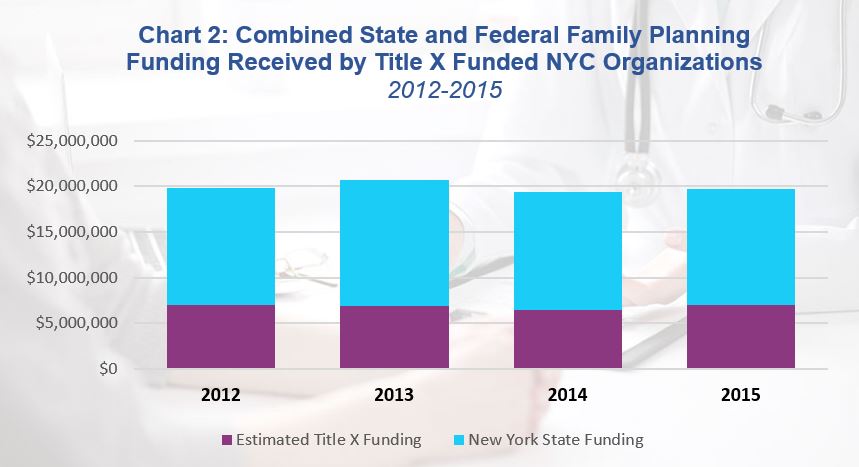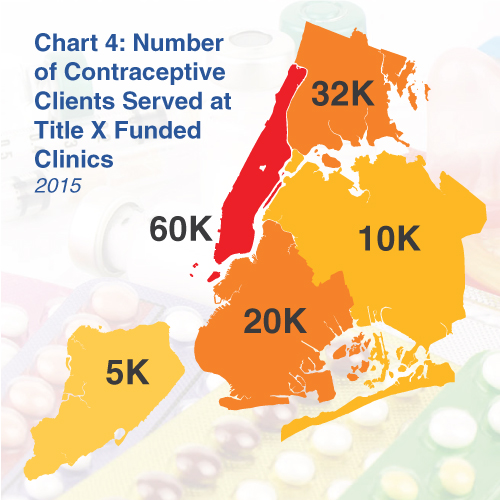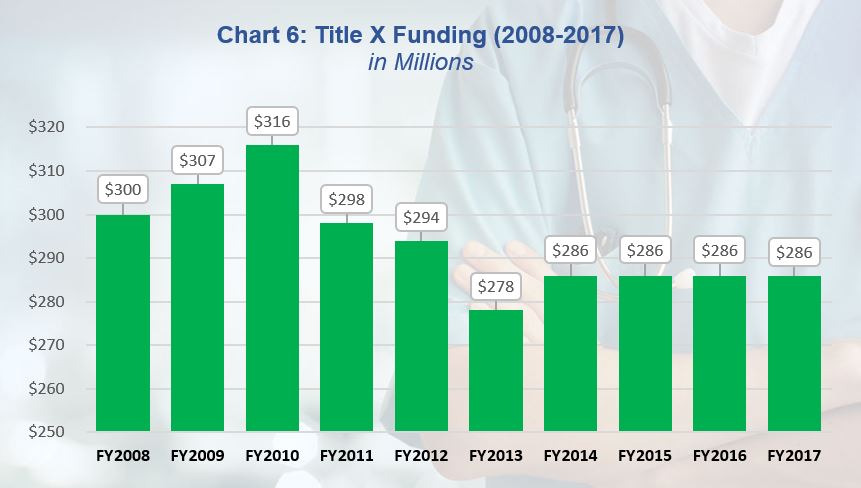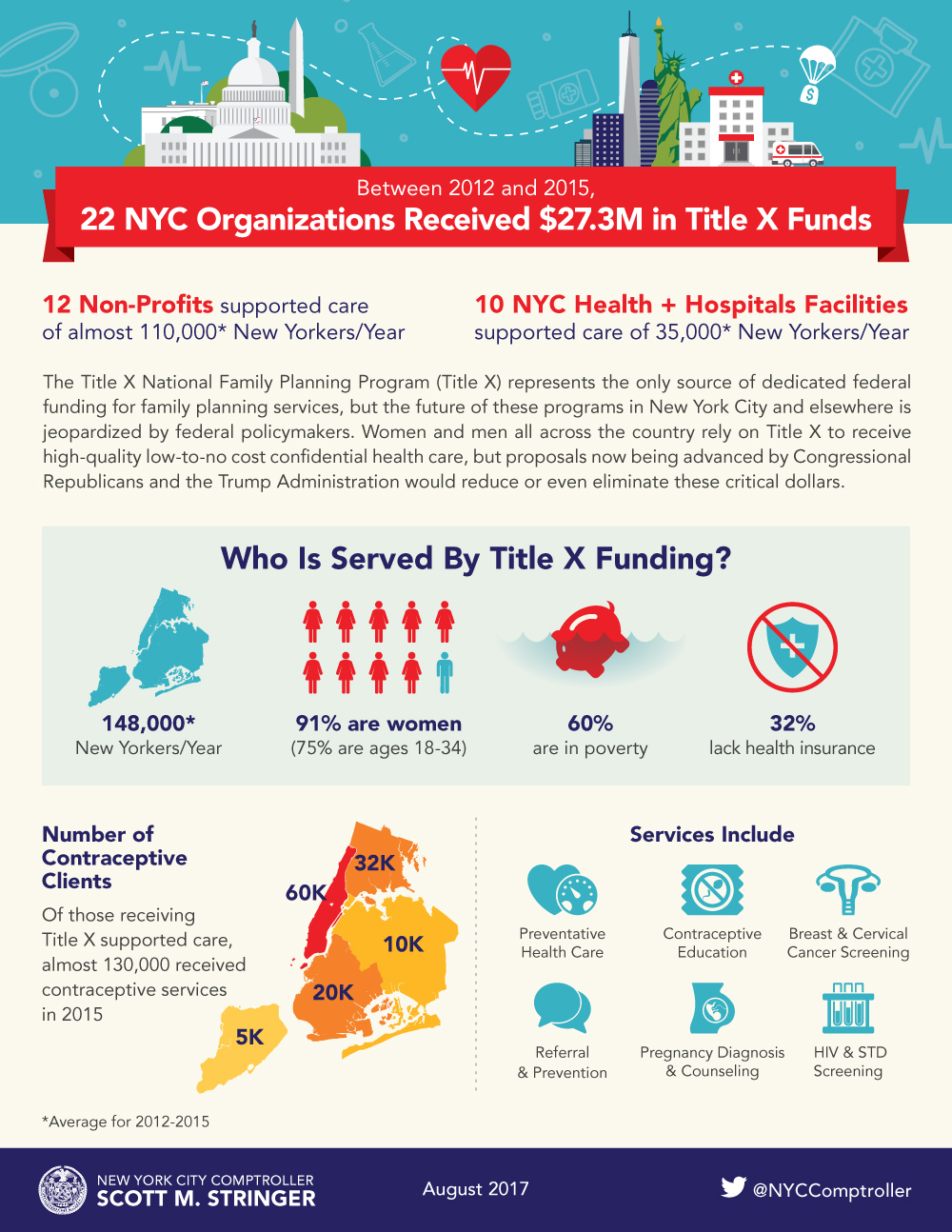Title X Funding in NYC: A Critical Resource That Must Be Protected
Executive Summary
Women and men all across the country rely on publicly-funded family planning services to receive health care, but the future of these programs in New York City and elsewhere is jeopardized by federal policymakers. As shown in this report from New York City Comptroller Scott M. Stringer, efforts to undercut family planning programs including the Title X National Family Planning Program (Title X) would harm thousands of New Yorkers, most of them low-income women who rely on these programs for their health care needs.
Family planning services help millions of people across the U.S. make health care decisions and obtain preventative health care services, including contraceptive education and counseling, preconception care, breast and cervical cancer screening, HIV and sexually transmitted disease screening, referral and prevention, and pregnancy diagnosis and options counseling. The Title X program, the only dedicated source of federal funding for these services, is administered by the U.S. Department of Health and Human Services (HHS).[1] The program is currently funded at approximately $286 million annually and provided health care to more than 4 million people nationally at some 4,000 sites across the country in 2015.[2] Title X services predominately benefit low-income and un-insured or under-insured individuals regardless of immigration status, many of whom, in the absence of these services, would lack access to health care services at all.[3]
While many New York City-based health care providers obtain funding from the Title X program, the overall impact of the program in the five boroughs has not been quantified. This report begins to quantify that impact. Using public reports authored by HHS and data obtained from the New York State Department of Health and Public Health Solutions, the two organizations responsible for dispersing Title X funds in New York City, the report finds that:
- Between 2012 and 2015, about 148,000 New York City residents received care supported by Title X funds on average each year.
- In 2015, across New York State, 91 percent of clients served were women, 60 percent had incomes at or below the poverty line, and 32 percent lacked health insurance according to federal data.
- In 2015, the most recent full year for which data is available, the 22 health care providers in New York City that received Title X funding collectively received about $7 million in federal Title X funding.
- Between 2012 and 2015, these 22 providers received a total of approximately $27.3 million in Title X funding. These providers also received additional State funding to support family planning services.
- In 2015, the 22 Title-X funded providers serving New York City operated 51 clinics in the five boroughs, according to the Guttmacher Institute, a leading research and policy organization committed to advancing sexual and reproductive health and rights in the U.S.[4]
- Of the 22 recipients of Title X funding during this time, ten were NYC Health + Hospitals sites that collectively received over $3 million in funding between 2012 and 2015. These funds helped to support the care of over 30,000 New Yorkers each year. In 2017, NYC Health + Hospitals reports that it will receive $1.3 million in federal Title X funds.
These vital services are particularly critical for women in New York City between the ages of 18 and 34, a higher percentage of whom are uninsured and therefore may be more likely to lack access to health care than women overall.[5] Women in this age range make up about two-thirds of all users of family planning services supported by Title X funding.[6]
However, funding for the Title X program is at risk. Specifically, the House of Representatives Appropriations Committee recently proposed eliminating Title X funding in FY18, even as funding for the program has fallen in the last decade.[7] In addition, numerous other legislative and administrative proposals have targeted providers of family planning services in ways that could make it harder for providers to deliver these critical services.[8] If successful, these efforts would undermine our city’s health care system, leaving thousands of men and women with limited or no access to their primary health care provider.
The Title X National Family Planning Program
Signed into law by President Nixon in 1970, the Title X National Family Planning Program (Title X) is the only federal program that provides dedicated funding for family planning and related preventative health services.[9] The program, which is currently funded at about $286 million annually, is administered by the U.S. Department of Health and Human Services (HHS) and supports health care services, including pregnancy testing, contraceptive counseling and services, pelvic exams, cancer screenings (including cervical and breast), sexually transmitted disease testing, and infertility services along with health education and referrals for health and social services.[10] Federal Title X funding does not pay for abortion services.
Title X funding supports low-to-no cost confidential health care services predominately for a racially diverse mix of women, many of whom are low-income and un-insured or under-insured, and without regard to immigration status. Specifically, according to the 2015 Family Planning Annual Report published by HHS, in 2015 Title X providers served more than 4 million Americans.[11] Of these 4 million people, about two-thirds had incomes at or below the poverty line, almost half lacked health insurance, about 90 percent were women, 30 percent identified as nonwhite, and 32 percent identified as Hispanic or Latino.[12]
The services provided by Title X funded health care providers are a critical part of our nation’s health care system. For example, in 2015, the Title X program supported about 1 million breast exams, 750,000 pap tests, almost 5 million sexually transmitted disease tests, and over 1 million HIV tests.[13] In addition, research from the Guttmacher Institute found that in 2015, health clinics funded by Title X helped women avert an estimated 822,000 unintended pregnancies, preventing about 278,000 abortions and 387,000 unplanned births.[14] That same research found that absent these services, in 2015 nationally the rates of unintended pregnancy and abortion would have been 30 percent higher overall and the unintended pregnancy rate 44 percent higher among teenagers.[15] The Guttmacher Institute also found that in 2010, the services provided by Title X funded clinics prevented 87,000 pre-term or low-birth-weight babies, 63,000 sexually transmitted infections, and 2,000 cases of cervical cancer.[16] Additional research has documented that this type of public investment in family planning programs reduces the need for more costly forms of health care, saving taxpayers as much as $7.09 for every public dollar spent.[17]
The Title X program is implemented by HHS through grants to service providers and state and local agencies. Funds are then sub-granted through a competitive process to a network of about 1,200 health care providers that ultimately receive Title X funding and provide health care services at a network of almost 4,000 sites across the country.[18] Because the funds are provided as up-front grants, they can be used flexibly by the recipients to support operations and programming, including remaining open on weekends, providing education programs, or adopting electronic medical records.[19]
Title X in New York City
To understand how the program serves New York City residents, the Office of the Comptroller obtained information from the New York State Department of Health and a non-profit organization called Public Health Solutions, the two entities in New York that receive grants directly from HHS.[20] Both then sub-grant this funding to a network of organizations that provided family planning services to New Yorkers.
The Department of Health and Public Health Solutions provided the Office of the Comptroller with a list of their sub-grantees, the amount of funding received by each sub-grantee, and the number of unduplicated clients served by each sub-grantee for each year between 2012 and 2015. This data revealed that 22 New York City based health care providers received Title X funding between 2012 and 2015. Of the 22 providers, 16 received funding only from the Department of Health, 2 received funding only from Public Health Solutions, and 4 received funding from both. Providers receiving Title X funds from the Department of Health also received additional State family planning funding. According to the Guttmacher Institute, these organizations operated over 50 health clinics in New York City in 2015.[21]
The Department of Health was unable to provide the Office of the Comptroller with the specific amount of Title X funding received by each entity that receives this funding because it does not disaggregate between federal and state funding in its grant amounts. Instead, the Department of Health provided the Office of the Comptroller with the amount of combined state and federal (Title X) funding received by each sub-grantee and an estimate of the percent that Title X funds comprised of the total amount of combined state and federal (Title X) family planning funding received annually by organizations in New York City.
Funding Amounts
As shown in Chart 1 below, between 2012 and 2015 the 22 organizations that received Title X funds collectively received approximately $27.3 million in total federal Title X funding, or about $6.8 million annually.
| Chart 1: Estimated Title X Funding Received by NYC Organizations 2012-2015 | |||
| 2012 | 2013 | 2014 | 2015 |
| $6,976,060 | $6,895,761 | $6,440,956 | $6,994,718 |
In addition, these 22 organizations also received approximately $52.3 million in State funding during this time, bringing the combined federal and state family planning grant funding for these health providers to a total of $79.6 million during this four year period. On an annual basis, these organizations collectively received approximately $20 million each year from the Department of Health and Title X grant program, as documented in Chart 2.

One of the largest recipients of Title X and Department of Health funding between 2012 and 2015 was NYC Health + Hospitals. Of the 22 recipients of Title X funding during this time, 10 were NYC Health + Hospitals sites that collectively received over $3 million in Title X funding. On average, each year between 2012 and 2015 more than 35,000 New Yorkers received family planning services supported by these funds. In addition to federal funding, these Health + Hospitals facilities also received state funding, bringing the combined total of state and federal funding for family planning services to $19.4 million during these four years. In 2017, NYC Health + Hospitals reports to the Comptroller’s Office that it will receive $1.3 million in federal Title X funds.
Clients Served
Between 2012 and 2015, the 22 organizations receiving Title X funds combined to provide health care services to an average of about 148,000 New Yorkers each year. Chart 3 shows that while the number of individuals utilizing health care services at centers supported by Title X funds fell slightly between 2012 and 2015, almost 140,000 New Yorkers (2 percent of the city’s total population) received family planning services at these centers in 2015.

Data from the Guttmacher Institute provides borough-specific detail about the number of people receiving contraceptive services from the 51 Title X funded clinics in New York City, of which 14 were located in the Bronx, 8 in Brooklyn, 16 in Manhattan, 6 in Queens, and 7 in Staten Island.[22] As shown in Chart 4, almost 130,000 women received contraceptive services from these Title X funded clinics in 2015, including over 60,000 women in Manhattan, 32,000 in the Bronx, and 20,000 in Brooklyn.[23]

The Guttmacher Institute’s research also sheds light on the impact of the 175 clinics located in New York State that receive Title X funding.[24] Across the state in 2015, these clinics provided contraceptive services to about 275,500 women, averting 59,200 unintended pregnancies, 27,900 unplanned births, and 20,000 abortions.[25] Reducing the number of unintended pregnancy, cancers, and sexually transmitted infections, investments in family planning programs have generated savings for New York taxpayers. According to the Guttmacher Institute, in 2010 the services provided at publicly funded family planning centers helped save almost $830 million in public funds.[26]
The HHS 2015 Family Planning Annual Report provides state-level demographic information about people who utilize health care services at Title X funded clinics. According to the report, users of these services were overwhelmingly low-income women who were either uninsured or utilized public health insurance benefits. Specifically, in New York State:
- 91 percent of clients served at these clinics were women;
- 60 percent of people accessing these services reported incomes at or below the federal poverty line and another 24 percent reported incomes between 100 percent and 250 percent of the poverty line; and
- 32 percent did not have health insurance, while 48 percent have public health insurance and 13 percent had private health insurance.[27]
While women of all ages obtain services at Title X funded clinics, women between the ages of 18 and 34 years old represent about three-quarters of all clients at clinics in the New York-New Jersey region. As shown in Chart 5, women between 18 and 34 years of age are more likely to lack health insurance than women overall in New York City.

Many of the uninsured women in this age group rely on publicly funded family planning clinics to meet their health care needs and would go without health care were it not for these clinics.[28] Indeed, research has found that six in ten women who obtain care from a publicly funded family planning clinic consider that clinic to be their primary source of health care.[29]
Family Planning Services Are at Risk from Federal Policy Changes
Numerous legislative proposals being considered in Washington and supported by Congressional leadership, including efforts to defund the Title X program entirely, would have a crippling impact on family planning services. Combined, these threats serve to jeopardize the future of federally funded family planning programs and the access to health care that they provide for hundreds of thousands of New Yorkers.
The most direct attack stems from the fact that Title X is a discretionary spending program, meaning that Congress can annually change the amount of funding for the program or eliminate funding for the program entirely. To that end, the House Appropriations Committee recently approved legislation that would defund the Title X program entirely in fiscal year 2018.[30]
While the Senate Appropriations Committee has not similarly called for the elimination of funding for the program, over the last decade, as growth in federal discretionary spending has been constrained, spending for the Title X program has fallen. As shown in Chart 6, Title X funding reached a peak of $316 million in Fiscal Year 2010 but has since fallen to $286 million, a drop of almost 10 percent, not adjusted for inflation.[31]

Alongside the potential for funding cuts to the Title X program itself, numerous other legislative and administrative actions and proposals would significantly harm family planning providers and the New Yorkers who rely on those services. For instance, numerous proposals in Congress, including in the House-passed American Health Care Act of 2017, would prevent Planned Parenthood, a major recipient of Title X funds and provider of health care services to New York City residents, from receiving any federal funding at all.[32] Similarly, earlier this year, President Trump signed into law legislation that allows states to effectively block organizations that provide abortion services from receiving Title X funds, and the Department of Health and Human Services recently reduced funding for teen pregnancy prevention programs.[33] Finally, as Title X providers also rely heavily on Medicaid to pay for services, any measures that would reduce Medicaid enrollment would also have the effect of increasing the number of people dependent on Title X for affordable family planning services. Absent significant funding increases, Title X funding would be insufficient to cover these increased costs, leaving health care providers unable to fully meet the needs of their clients.
Combined, the impact of these proposals would be devastating to the women and men who rely on Title X family planning services for their health care needs. The Title X program provides vital health care services to vulnerable women and men across New York City. The services are a critical part of the health care system across the five boroughs and should not be undercut as the result of misguided decisions in Washington.
Appendix
Appendix 1

Acknowledgments
Comptroller Stringer thanks Zachary Schechter-Steinberg, Deputy Policy Director, and the lead author of this report. He also recognizes the important contributions made by David Saltonstall, Assistant Comptroller for Policy; Jennifer Conovitz, Special Counsel to First Deputy Comptroller; and Angela Chen, Senior Web Developer and Graphic Designer. The Comptroller also thanks the staff at the New York State Department of Health and Public Health Solutions for their assistance in this project.
Endnotes
[1] https://www.hhs.gov/opa/sites/default/files/title-x-fpar-2015.pdf
[2] https://www.whitehouse.gov/sites/whitehouse.gov/files/omb/budget/fy2018/hhs.pdf and https://www.hhs.gov/opa/sites/default/files/title-x-fpar-2015.pdf
[3] https://www.nationalfamilyplanning.org/file/Title-X-101-February-2017-final.pdf
[4] https://www.guttmacher.org/report/publicly-funded-contraceptive-services-us-clinics-2015
[5] 2015 American Community Survey
[6] https://www.hhs.gov/opa/sites/default/files/title-x-fpar-2015.pdf
[7] https://appropriations.house.gov/uploadedfiles/23920.pdf
[8] https://www.cbo.gov/publication/52752 and https://www.revealnews.org/article/trump-administration-suddenly-pulls-plug-on-teen-pregnancy-programs/ and https://www.congress.gov/bill/115th-congress/house-joint-resolution/43/text and https://www.washingtonpost.com/opinions/trump-names-a-birth-control-czar-who-doesnt-believe-in-birth-control/2017/05/04/5de459f8-3101-11e7-8674-437ddb6e813e_story.html?utm_term=.a316a5014ce7
[9] https://www.nationalfamilyplanning.org/file/Title-X-101-February-2017-final.pdf and https://www.hhs.gov/opa/sites/default/files/title-x-fpar-2015.pdf
[10] https://www.nationalfamilyplanning.org/file/Title-X-101-February-2017-final.pdf
[11] https://www.hhs.gov/opa/sites/default/files/title-x-fpar-2015.pdf
[12] https://www.hhs.gov/opa/sites/default/files/title-x-fpar-2015.pdf
[13] https://www.nationalfamilyplanning.org/file/Title-X-101-February-2017-final.pdf
[14] https://www.guttmacher.org/gpr/2017/01/why-we-cannot-afford-undercut-title-x-national-family-planning-program
[15] https://www.guttmacher.org/gpr/2017/01/why-we-cannot-afford-undercut-title-x-national-family-planning-program
[16] https://www.guttmacher.org/gpr/2017/01/why-we-cannot-afford-undercut-title-x-national-family-planning-program
[17] https://www.ncbi.nlm.nih.gov/pmc/articles/PMC4266172/pdf/milq0092-0667.pdf
[18] https://www.hhs.gov/opa/sites/default/files/title-x-fpar-2015.pdf
[19] https://www.guttmacher.org/gpr/2017/01/why-we-cannot-afford-undercut-title-x-national-family-planning-program
[20] https://www.hhs.gov/opa/sites/default/files/title-x-directory-grantees.pdf
[21] https://www.guttmacher.org/report/publicly-funded-contraceptive-services-us-clinics-2015
[22] https://www.guttmacher.org/report/publicly-funded-contraceptive-services-us-clinics-2015
[23] https://www.guttmacher.org/report/publicly-funded-contraceptive-services-us-clinics-2015
[24] http://www.guttmacher.org/sites/default/files/report_downloads/publicly_funded_contraceptive_ services _2015_tables_1-7.pdf
[25] http://www.guttmacher.org/sites/default/files/report_downloads/publicly_funded_contraceptive_ services _2015_tables_1-7.pdf
[26] https://www.guttmacher.org/sites/default/files/factsheet/fp-ny.pdf
[27] Notably, as the number of uninsured New Yorkers has fallen since enactment of the Affordable Care Act, the percent of people accessing publicly funded family planning services without health insurance has fallen from almost half in 2012 to about one-third in 2015.
[28] https://www.nationalfamilyplanning.org/file/Title-X-101-February-2017-final.pdf
[29] https://www.guttmacher.org/sites/default/files/report_pdf/sources-of-care-2013.pdf
[30] https://appropriations.house.gov/uploadedfiles/23920.pdf
[31] https://www.gpo.gov/fdsys/browse/collectionGPO.action?collectionCode=BUDGET
[32] https://www.congress.gov/bill/115th-congress/house-bill/1628/text
[33] https://www.congress.gov/bill/115th-congress/house-joint-resolution/43/text and https://www.revealnews.org/article/trump-administration-suddenly-pulls-plug-on-teen-pregnancy-programs/